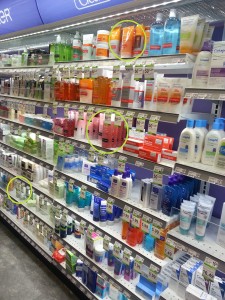
The products enclosed by green circles have plastic exfoliating beads (2014). Photo courtesy of Gwen Gallagher
Facial washes are extremely popular products used for deep cleanses and are an integral part in most people’s daily routine. They are especially helpful for preventing acne and giving the consumer a refreshed feel. Some face washes contain exfoliating beads to improve the soap by mechanically removing the outmost layer of skin. The beads help remove dead skin layers and any debris from the day to reveal smoother skin and facilitate the growth of healthy, rejuvenated skin. The exfoliating beads tend to be made of out plastic and were considered ideal for the consumer because of the guaranteed smooth surface, which reduces the potential for redness and irritation of the skin. Unfortunately, the beads are so small that they can slip through water treatment facilities and plastic is not easily degradable. As a result, plastic microbeads are accumulating in marine environments and posing a threat to the organisms.
Microplastic pollutants are particles smaller than 5 millimeters in diameter, as defined by the National Oceanic and Atmospheric Administration. In the specific case of exfoliating beads, the diameter tends to be roughly 60-800 micrometers in diameter according to research conducted by Michelle Chang. Michelle determined how often the facial washes with exfoliating beads were being used. She utilized this study to approximate how much plastic waste is produced by the average consumer of facial wash through the trends of students at UC Berkeley. According to her approximations, 35% of facial wash consumers use products with plastic exfoliating beads, and each consumer is responsible for up to 2.68 grams of plastic a year from facial wash usage.
The exfoliating beads are so small that they are passing through water treatment facilities with ease and accumulating in the environment, which in turn has a negative effect on the aquatic ecosystems. Microplastic exfoliating beads are not considered chemically toxic to the environment or organisms, but they also do not degrade easily. The plastic particles are primarily made of polyethylene, which is one of the reasons why they do not break down easily. According to Anthony Andrady, who focuses his research on microplastic pollution and its effect on aquatic organisms, microplastics are less likely to degrade in a marine environment because the water prevents the plastic from getting hot and being overexposed to oxygen. Heat and high oxygen levels are two common conditions for plastic degradation. This means that the plastic already in marine environments has to be removed manually and the problem will not fix itself within a reasonable time frame.
Once in the environment, the exfoliating beads start to have negative effects as the concentration of the pollution increases. Marine organisms are ingesting the beads at high rates. For example, Andrady says that it is documented that 44% of marine bird species are known to ingest plastics. Additionally, there are verified accounts of some birds feeding plastics granules to their offspring. The microplastics are also roughly the size as krill, which encourages larger fish to ingest the plastic.
When fish start to eat the exfoliating beads, the pollution enters the food chain. According to studies reviewed by Stephanie Wright, the microplastic particles can be incorporated into the food chain when the organisms lowest on the food chain ingest and transfer the plastic to additional organisms once they have been eaten. Eventually, endangered animals that are usually safe from the plastic beads could have the plastic pollution transferred to them through the food chain. The idea of microplastic transfer up the food chain was confirmed by Outi Setala, who studies the ingestion of microplastics zooplankton taxa.
Additionally, John B. Colton conducted studies that reveal plastic beads are found in the stomachs of many fish studied along the New England coast, which ultimately leads to intestinal blockage problems. The same study also introduces the idea of bacteria and microscopic pathogens clinging to the plastic particles and being transported over large bodies of water.
Sherri Mason spoke of this phenomenon of microscopic organisms clinging to the plastic particles in a recent interview with National Public Radio.She said, “I think the biggest [threat] is that actually they kind of connect to all of the different issues that are impacting the Great Lakes, right? So they become a way for invasive species to move from one area to another because the species will actually cling to the plastic and move with the plastic. And so, essentially, the plastics themselves kind of almost become this conglomeration for all of these other issues.”
So what is being done about this problem? New York is currently working on new legislation to be the first state to ban the use of plastic microbeads in consumer facial wash products. Some companies, such a Procter and Gamble and Colgate-Palmolive have started to phase out the use of microbeads. While laws slowly start to change and companies improve their products, it is also important for consumers to change habits towards purchasing greener products. According to a Mintel study examined, the top grossing brands of facial cleaners with plastic exfoliating beads are produced by Clean & Clear, L’Oreal, and Neutrogena as of 2013. Since then, Clean & Clear has stopped using microplastics in its products. Using this information and knowing the harmful effects, the public can help to reduce waste production and stop the endangerment of aquatic ecosystems by making the easy change to more environmentally friendly face washes that do not include plastic.